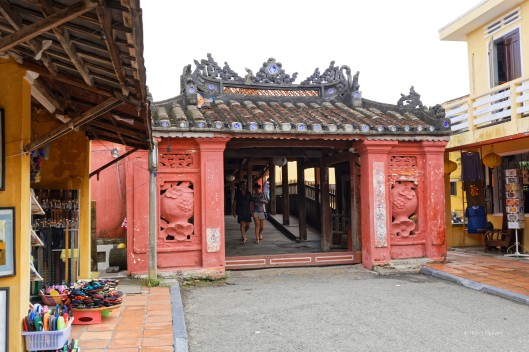We flew to Đà Nẵng in Central Việt Nam, and from there went by road to Hội An, a small coastal city designated a World Heritage Site in 1999.
Hội An was a busy trading port until the end of the 18th century, with Chinese, Japanese, Portuguese, and Indian traders establishing themselves in various parts of the city. Then two factors contributed to its decline: the Nguyễn dynasty which came to power in Việt Nam gave their French allies access to Đà Nẵng as a main trading port; and the Thu Bồn river passing through Hội An silted over, making it more difficult for ships to use the harbor.
Soon eclipsed by Đà Nẵng, Hội An languished until recently when international tourism discovered its charms. The old quarters along the river have been preserved much as they were originally. The pace of life is much more relaxed than in cities like Sài Gòn or Đà Nẵng, and it is possible to stroll leisurely along its streets without being bothered by cars or motorbikes. Walking is what we did over two days in Hội An from our homestay lodging to the old quarters, both during the day and at night.
During the day, it was easier to see the old assembly halls or temples, some dating back to the 16th century.











Our Hoi An is beautiful and steeped in history. Sounds like you are having a great time. Amazing shots, perfect light. 🙂
LikeLiked by 1 person
Thank you for visiting this blog and commenting!
LikeLike
What beautiful structures and colors, Hien!
LikeLiked by 1 person
Thanks Donna!
LikeLiked by 1 person
Beautiful pictures from the old quarters! Very charming atmosphere, no wonder tourists have discovered it.
LikeLiked by 2 people
Thank you Tiny. I hope the town does not become too touristy and lose its old chamrs.
LikeLiked by 1 person
A very nice series. I really like that you’ve included the little girl and her grandmother. It makes the series very personal.
LikeLiked by 2 people
Thank you Tim. Glad you like the photos. That one, of the girl and her grandmother, is one of my favorites.
LikeLike
I can see why it’s one of your favorites.
LikeLiked by 1 person
Wonderful photos, beautiful architecture!
LikeLiked by 2 people
Thank you!
LikeLike
Everything is so bright and colorful, even at night when lit by the lanterns! I’m loving this look at your homeland, and I’m learning aa great deal from it.
LikeLiked by 2 people
Thanks Jerry. The bright sun helped a lot, compared to the cloudy skies that we have experienced since coming back to New Jersey.
LikeLiked by 1 person
Beautiful photos sweetie! I hope you had a great Thanksgiving! Hugz Lisa and Bear
LikeLiked by 2 people
Thank you Lisa! I hope you had a great Thanksgiving too.
LikeLike
Your photos are beautiful! I absolutely loved the old quarters of Hoi An, so colourful. And so atmospheric after dark when millions of lanters are lit up.
LikeLiked by 2 people
Those lanterns do make a difference! Thanks for commenting.
LikeLike
That must have been a welcome pace after the big cities. Lovely photos. I love how the buildings are so ornate and colorful.
LikeLiked by 2 people
You are right, Katelon. We all welcomed the relaxed, small town pace.
LikeLiked by 1 person